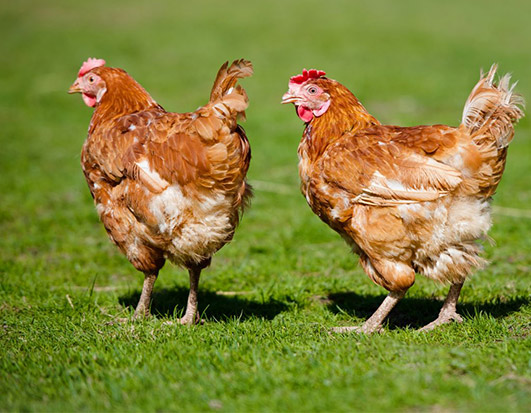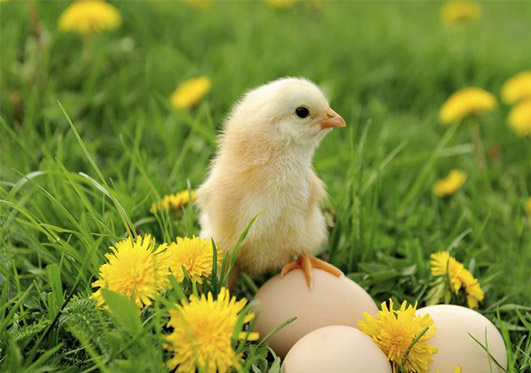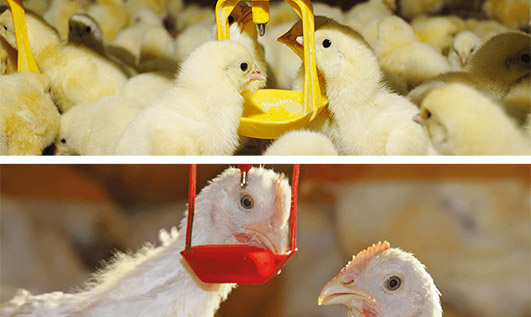Which Factors Affect Size of Eggs in Chicken Feed?
Studies have shown that within a certain range, the content of some trace components in eggs is significantly affected by chicken feed. The content of nutrients varies, which affects the quality and size of the eggs.
Protein and amino acid levels in feed, protein intake is the main nutritional factor that affects egg size. Adjusting the protein level of the diet can change the size of the egg. Each one increase or decrease in dietary protein levels, such as from 16% to 17% or 15%, can increase or decrease the weight of the egg by approximately 1.2 grams. In practice, it is best not to increase or decrease the protein by more than 1 percentage point each time. Amino acid nutrition is the essence of protein nutrition.

The effect of dietary energy levels on egg weight is mainly through feed intake. If the daily energy intake of layer hens is lower than the lower limit of the above values, the egg production and egg weight will be affected, and thus affect the protein's Food intake (or protein savings) allows hens to have higher protein levels for maintenance, egg production and increased egg weight.
Essential fatty acids play an important role in the factors that affect egg weight. Linoleic acid is involved in fat metabolism, so it affects the size of the egg through its effect on the yolk.
Attention Chicken Farming Points in Summer
- Do not mix the feed water with porridge-like chicken. Thinners tend to dilute the digestive juices and reduce the activity of various digestive enzymes, resulting in incomplete feed digestion, poor nutrient absorption, and even indigestion, which greatly reduces feed utilization. Chickens are also prone to fat deposits because of their thinner skin, and their subcutaneous fat is too thick to cater to consumer preferences.
- Try to use a free drinking fountain, or plastic cover drinking fountains, such as the use of plastic cover drinking fountains best hanging up, to the chicken can drink water is appropriate to ensure that the chicken has sufficient clean drinking water.

- When the weather is hot, it can be fed in the morning and in the evening and it can improve the feed intake of chickens. Wet material can be used at noon, and the ratio of material to water is suitable for 1:0.5-2. The degree of opening is better. Generally, feeding dry materials in the morning and feeding wet materials at noon can stimulate chickens to eat more food.
- When your chickens run into high temperature, you can add glucose and vitamin C to your drinking water, which can increase the energy lost due to lack of feed intake. It can also enhance the chicken's physique and anti-stress ability. It also has certain auxiliary treatment effects on high fever.
Farming Points and Management For Free-range Chickens
Farmers can choose the right brooding season in order to facilitate the grazing of ecological chickens. The best season of farming is in March to May, when the survival rate of brooding is high. By the middle chicken stage, due to suitable temperatures and long hours of outdoor activities, it can be fully exercised and exercised, resulting in strong physique, which is very beneficial to natural grazing, feeding and prevention of natural enemies in the future. Spring chicks are sexually mature and have long duration of egg production, especially chicks hatching in early spring.

Feeds on ecological chickens must be organic feed. Therefore, when planting ecological chicken feed ingredients, it must comply with the requirements of organic foods, and animal feeding supplements that are artificially supplemented must also comply with the standards for the production of organic foods. It is forbidden to add chemicals during the production of artificial feed to ensure the quality of ecological chickens. The quality of natural feeds depends on the natural environment. There are natural forages, mature fruit and various natural insects. Only ecological chickens have enough natural feed and nutrition to produce high-quality products with high nutritional value and nourishing properties.
How to Scientifically Avoid the Early Death of Chicks?
In many cases, because farmers do not properly grasp the knowledge of scientific feeding and management of chicken farms, it is easy to cause the early death of chicken farms, thus affecting the survival rate of chicks and further affecting the ultimate chicken efficiency. How do you scientifically avoid the early death of a chick when raising in poultry cages for sale.
Drinking water must be timely: especially after long-distance transportation of chicks, be sure to drink water in time, otherwise it will cause dehydration. Take a free drinking method and drink 5% of sugar water for the first time.

The temperature should be appropriate. The chicks are sensitive to temperature and maintain a 35-32 reduction trend within 1-3 weeks after hatching, increasing with age, and decreasing 2-3 times per week thereafter.
The density should be appropriate. if the brood density is too high, there will be more harmful gases in the house, and it will produce worms; the brood density is too small, the brooding area and equipment are not fully utilized, resulting in waste. The average density for flat raising is 20 per square meter, and 40-50 per square meter for cage raising.
Knowledge of Baby Chicks Drinking Water
The moisture content of chicks is about 60%-70%. It exists in all the cells of the chicken body. Loss of 10% of water due to dehydration or excretion can cause dysfunction, and loss of 20% of moisture can cause death. Water is very important for all physiological processes such as digestion, metabolism and respiration. Water can regulate body temperature through absorption and discharge.

If you use a nipple drinkers introduced by reliable poultry farm equipment suppliers of chicken cages for sale after 1 week, each bird should have 1.8cm of drinking water. To calculate the drinking space, calculate both sides of the trough waterer. Place the drinking fountain so that the chicken can find drinking water within a range of no more than 2.5m. The height of the drinking fountain should be kept at the height of the back of the chicken. Generally, broilers do not control drinking water. The amount of water consumed by chickens is generally 1.5-2.5 times that of feed. The higher the temperature, the greater the amount of drinking water. Drinking water should be changed every day, and the drinking fountain should be cleaned and disinfected before water injection.
What is the Role of Minerals on Chicken Farming?
Calcium, phosphorus, sodium, potassium, manganese, and chlorine are involved in the formation of egg shells, improving the quality of egg shells and improving the quality of eggs and chicks. Changes in maternal phosphorus levels can affect the ash in the skeleton of chicks from primiparous hens. Therefore, the appropriate level of phosphorus must be provided in chickens feed equipments used in poultry farming to ensure the integrity of the bones during the early growth and development stages of the chicks.

For the study of minerals in feeds, what is most important is to use effective compound forms to increase the ability of the mother to transport these substances into tissues, eggs, and embryos. At present, the vast majority are concentrated on the research of antioxidants and on the role of selenium. Selenium-methionine a can improve the antioxidant capacity of vitamin E and eggs, embryos, and chicks within 10 days of age. Supplementation of zinc-methionine and manganese-amigo acid mixtures can improve chick immunity and survival.
